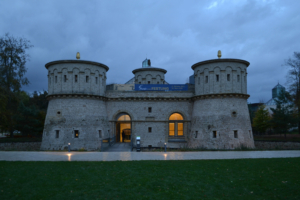Hello friends. Welcome to the top must-visit museums in luxembourg article.
Luxembourg is a remarkable combination of ancient class and modern innovation, set between the beautiful Ardennes Mountains and the flowing Moselle River. The country’s rich history, which dates back to Roman times, has molded its distinct character, which can be seen in its cobblestone streets, fortified walls, and towering cathedrals.
Luxembourg, on the other hand, is a vibrant center of contemporary culture, with a booming arts sector, a robust culinary industry, and a hospitable ambiance that welcomes travelers from all over the world.
Luxembourg’s enormous network of museums is at the core of its cultural tapestry, each a storehouse of tales and artifacts that document the country’s past, commemorate its creative triumphs, and provide insights into its unique heritage. The majestic halls of the National Museum of History and Art, as well as the inventive galleries of Mudam Luxembourg, are testaments to Luxembourg’s dedication to maintaining its rich cultural legacy and creating a dynamic creative community.
As the year 2024 approaches, Luxembourg’s museums prepare to launch a series of fascinating exhibitions and activities, encouraging art lovers, history buffs, and curious minds to embark on a trip through time, art, and culture. There’s plenty for everyone to discover, from the investigation of Luxembourg’s industrial legacy at Fond-de-Gras Mines to the enthralling world of modern art at Mudam Luxembourg.
Whether you’re a seasoned art connoisseur or a first-time visitor to the world of cultural exploration, Luxembourg’s museums offer an irresistible invitation to delve into the country’s rich heritage, engage with its artistic spirit, and experience the unique tapestry of a country that seamlessly blends the old and the new.
Table of Contents
Stroll through Luxembourg’s Historic Fortress at the Villa Vauban
The magnificent Villa Vauban, located in Luxembourg City, is an art museum that takes you on a trip through the beauty of 18th- and 19th-century paintings collected from private collections. Let’s have a look at the fascinating history and incredible artifacts that make this museum a cultural treasure.
Discovering the Villa’s Legendary Past
The Villa was built in 1873 as a private property, although its origins may be traced back to a fort built as part of the city’s fortifications by Sébastien Le Prestre de Vauban (1633–1707). An impressive part of the medieval fortress wall exists in the museum’s basement as a monument to the historical groups beneath. Philippe Schmit of Luxembourg’s architectural brilliance, Diane Heirent & Philippe Schmit, managed the 2010 refurbishment, which added a modern touch, winning the expansion the coveted TECO Architecture Award.
A Journey Through Time: History Revealed
Gabriel Mayer, an Alsacian glovemaker, built the house, and Jean-François Eydt, a city architect, designed it. The mansion is a masterwork in classical 19th-century design with a Neoclassical exterior. The structure, which was built on a large site made available after the city’s walls were demolished, included not just the palace but also stables and an open French-style garden. Steel magnate Charles Joseph de Gargan and businessman Norbert Le Gallais were among the major owners. The house was repurposed for the ECSC Court of Justice in 1949 before being transformed into the art refuge we know today in 1959 by the City of Luxembourg.
The Tapestry of the Arts: Timeless Collections
The artifacts collected by the museum are drawn from three unique collections donated to the city. The first collection contains 17th-century Dutch paintings, contemporary French classics, sculptures, and sketches from banker Jean-Pierre Pescatore (1793–1855). The second is a collection of 19th-century paintings by Leo Lippmann (1808–1883), a banker and Consul General of Luxembourg in Amsterdam. Jodoc Frédéric Hochhertz had the third collection, which Eugénie Dutreux-Pescatore (1810–1902) later bought. It consists of historical paintings, still lifes, and portraits from the 18th century.
Dive into the Dutch Golden Age with works by Cornelis Bega, Gerrit Dou, and Jan Steen, or marvel at the 19th-century French compositions by Eugène Delacroix, Jean-Louis-Ernest Meissonier, and Jules Dupré. The buiulding serves as a time capsule, retaining the spirit of creative excellence over generations.
Finally, the museum welcomes you to explore its halls, where history, art, and invention come together to offer an unforgettable experience. Discover the spirit of Luxembourg’s creative legacy as the Villa meticulously maintained treasures continue to weave stories.
Opening Hours
- Wednesday to Monday: 10:00 AM to 6:00 PM
- Friday: 10:00 AM to 9:00 PM
Closed Days
- 1 November
- 25 December
- 1 January
Pricing
Adult Standard Rate: €5
Special Discounts
- Every Friday from 6:00 p.m. to 9:00 p.m., admission is free.
21-year-old youth: Free Admission
Students aged 26 and up: €3 (with student ID).
Youth aged 21 to 26, Carte jeunes holders, and those over the age of 60: €3.
Disabled People: Free Admission
Muséeskaart, LuxembourgCard, Amis des Musées Luxembourg, ICOM, Kulturpass, Press: Admission is free.
- Groups (minimum of 10 people): €3 per person; Guide: €100
People with Special Needs Groups
Entrance is free; the guide costs €100. - Primary Schools in Luxembourg City: Free Admission
Primary Schools from Other Parishes or Abroad: Free Admission; Guide: €90; Workshop with Guided Tour: €100
Luxembourg Secondary Schools or Visitors from Other Countries: Free Admission; Guide: €90; Workshop with Guided Tour: €100
Passport for a Year
The “Muséeskaart” is a yearly passport that grants entrance to up to seven museums in Luxembourg City. This passport allows for year-round study of creative marvels, guaranteeing that the beauty of culture is accessible to everybody.
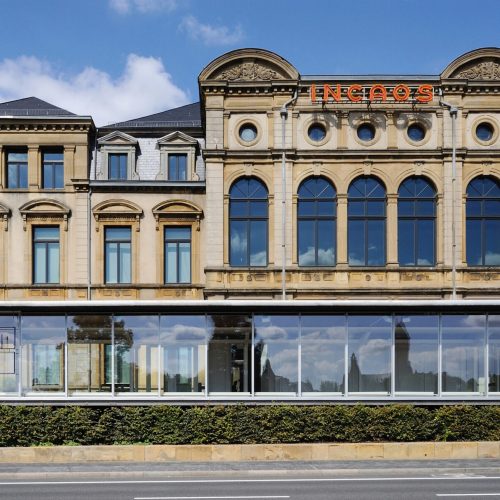
Discover Luxembourg’s Past and Present at Casino Luxembourg
Explore the captivating history of the Casino Luxembourg, a thriving hub for contemporary art that underwent a transformational makeover in 1995, taking on a new function as a showcase for temporary Luxembourg art exhibits. The Casino Bourgeois, which opened in 1882, smoothly combined gambling with social and artistic activities.
A Peek into the Past
The Casino Bourgeois was built in 1882, thanks to the brilliant Luxembourg architects Pierre and Paul Funck. Aside from gambling, the casino had a reading area, a cafeteria, and large rooms that held a variety of cultural events such as lectures, balls, plays, performances, concerts, and art exhibitions. On July 19, 1886, the legendary Franz Liszt performed his final piano recital at the casino. During the First World War, the casino took on a new duty, acting as the Kaiser’s headquarters.
From the Foyer Européen to the Casino Luxembourg
The Cultural Circle of the European Communities leased the casino after the state purchased it in 1959, and they gave it the new name Foyer Européen. The same year, René Maillet, a renowned architect, built a spectacular glass and steel pavilion.
Fast forward to 1995, when Luxembourg City was named the European Cultural Capital. Under the direction of Swiss artist Urs Raussmüller of Schaffhausen’s Hallen für Neue Kunst, the casino underwent a creative metamorphosis. The objective was to transform the space into a sizable exhibition space with hanging space and open-top, white-walled cubes placed thoughtfully all around the structure. The reception and information center replaced the entry hall. After the European Year of Culture concluded in March 1996, the casino effortlessly moved into its current position as a lively platform for contemporary art.
The Infolab: A Literary Haven
The Infolab, a public library and reading area, is housed within the casino’s walls. The Infolab is a rich trove of knowledge, including over 7,000 volumes on art history dating back to the 1960s, 50 portfolios featuring Luxembourg artists, and 40 foreign periodicals addressing contemporary art and culture. Visitors may learn about current exhibitions through movies, magazines, and publications related to the featured artists.
Making the Future: Casino Luxembourg as a Center for Creative Expression
As the Casino Luxembourg evolves, its rich history weaves itself into the lively fabric of Luxembourg’s creative environment. It is a living tribute to the synthesis of culture, history, and current art, as well as a testament to architectural perfection. Accept the temptation of Casino Luxembourg—a refuge where the past meets the present, encouraging people to celebrate creativity and expression.
Opening Hours
Monday through Wednesday, Friday through Saturday, and Sunday: 11 a.m. to 7 p.m. Thursday, from 11 a.m. to 9 p.m. On Tuesdays, the casino takes a moment of relaxation and innovation to offer a chance to recharge. Also, keep the following dates in mind for closure: January 1st, November 1st, and December 25th.
The entrance is free
Uncover Luxembourg’s Natural Wonders at the National Museum of Natural History
This museum, located in Luxembourg City’s Grund neighborhood on the eastern bank of the Alzette River, is an amazing trip through the wonders of the natural world.
A Look at Nature’s Diversity
Dive inside the museum’s center to discover an extensive collection of scientific sciences. The museum includes a wide range of sciences with eight distinct divisions, including botany, ecology, geology, minerals, geophysics, astrophysics, palaeontology, vertebrate zoology, and invertebrate zoology.
Developing Scientific Curiosity Since 1850
The Museum of Natural History has its origins in 1850, when the Society of Natural Sciences was founded under the auspices of Prince Henry, the newly appointed Governor of Luxembourg, representing Grand Duke William III. The purpose of society was clear: to educate the public about the glories of natural science and history.
To jumpstart this ambition, the government gave the group a piece of the municipal Athenaeum, today known as the National Library. The first exhibit, which opened in 1854, had fossil specimens displayed over three rooms. However, rising demand for exhibition space forced a relocation to the Vauban Barracks in Pfaffenthal in 1892.
Changing Environments: From the Barracks to the Fish Market
The Vauban Barracks housed the museum for numerous decades, although its tourist appeal was criticized. In response, the museum relocated to the Old Gendarmerie on the Fishmarket in 1922, sharing space with the Museum of History and Art.
Despite obstacles, the Fishmarket building survived the Second World War, allowing for a quick comeback after the war. However, the museum’s concentration shifted after WWII, extending into geophysics and astrophysics. Notably, the museum acquired the country’s first electron microscope.
A New Chapter for Saint Jean’s Hospice
The growing interest in several scientific subjects led to a search for a more spacious location. Finally, the Chamber of Deputies authorized the renovation of Saint Jean’s Hospice in Grund on January 11, 1990. This decision was a watershed moment, culminating in the new site’s inauguration in June 1996.
Displays, Classrooms, and Laboratories: A Trio of Excellence
The renovated museum currently spans three unique buildings, each serving a different aspect of its activities. The Museum of Natural History is a beacon of scientific enlightenment, with awe-inspiring collection displays, cutting-edge research facilities, and engaging teaching classrooms.
At the Museum of Natural History, embark on an enthralling trip through Luxembourg’s ecological treasures, where every nook mirrors the majesty of the natural world.
Opening Hours:
- Monday is a day off.
- Tuesday, 10:00 a.m. to 6:00 p.m.
- Wednesday, 10:00 a.m. to 6:00 p.m.
- Thursday, 10:00 a.m. to 6:00 p.m.
- Friday, 10:00 a.m. to 6:00 p.m.
- Saturday, 10:00 a.m. to 6:00 p.m.
- Sunday, 10:00 a.m. to 6:00 p.m.
Please keep in mind that the museum is closed on Mondays but open from 10:00 a.m. to 6:00 p.m. the rest of the week. Use these hours to immerse yourself in the engaging exhibitions and learn about the fascinating realm of natural history at your own pace.
Admission Rates
The daily rate is €5.
Seniors (65 and older) and people with limited mobility
The daily rate is €3.
Please keep in mind that guided tours have a fixed price of €60 for groups of up to 25 people.
Group Visits:
For groups of more than 25 people, please make arrangements with the museum in advance. Whether you’re a soloist or a group, our low prices ensure that everyone has the opportunity to discover the treasures of natural history.
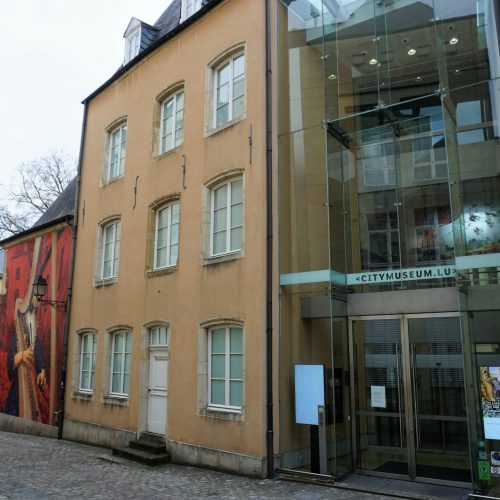
Journey Through Time at the Luxembourg City Museum
The Luxembourg City Museum, formerly known as the Luxembourg City History Museum, is located in the center of Luxembourg and serves as a tribute to the city’s millennia-long history. This architectural masterpiece, created on June 22, 1996, by Luxembourg’s own Conny Lentz and the skill of Repérages in Paris, meticulously knits together permanent and rotating exhibitions.
Architectural Symphony: Bringing Past and Present Together
The museum, like the city it calls home, perfectly blends antiquity with modern flare. These houses, housed in painstakingly restored constructions ranging from the 17th to the 19th centuries, murmur stories from the Middle Ages. The floating glass façade and a panoramic elevator that reveal stunning views across all levels are notable instances of integrating historical charm with modern aspirations.
The panoramic lift, housed in a large glass cage, can hold up to 65 people and provides stunning views of the rock foundations on lower levels as well as panoramic views over Luxembourg’s Grund area and Rham plateau on top levels. This architectural accomplishment depicts the evolution of Luxembourg over the years. Further exploration reveals old vaulted vaults unearthed during excavation in the early 1990s.
A History of Immersive Galleries, Below and Above Ground
Visitors descend below street level to find a permanent collection documenting the town’s architectural and urban growth. A vibrant area awaits on the top levels, especially for exciting temporary exhibitions. The incorporation of a multimedia system that spans the whole structure tells the story of the town, including its cultural, political, and social transformations. This system provides access to ten thousand papers and roughly sixty audio-visual sequences.
The Enchanting Rue du Saint-Esprit: Where History Meets the Present
The Ltzebuerg City Museum, located on the scenic route du Saint-Esprit in the old town, attracts both history buffs and casual tourists.
As you enter the cobblestone streets, Conny Lentz’s stunning architecture and Repérages’ elegant storytelling lead you through Luxembourg’s rich tapestry.
Finally, the Letzebuerg City Museum is a live monument to Luxembourg’s continuing history, not just a store of historical items. Its architectural symphony blends the ancient and the contemporary, encouraging visitors to travel across time. With each exhibit, it reveals a new chapter in Luxembourg’s history, ensuring that the echoes of its past go on through generations.
Opening Hours
- Monday: Closed
- Tuesday,Wednesday,Friday, Saturday, and Sunday: 10 a.m.–6 p.m.
- Thursday: 10AM-8PM
Pricing
Adults pay a standard rate of €5.
Special Offers:
- Every Thursday from 6-8 p.m., admission is free.
- Youth (under the age of 21): Admission is free
- Students (under 26 years old with valid student ID): €3.
- Youth (21 to 26 years old), Carte jeunes holders, and the elderly (over 60 years old): €3.
Disabled people: free admission
Amis des Musées Luxembourg, Muséeskaart, LuxembourgCard, ICOM, press: Free admission
Kulturpass
Group Tours: A Unique Experience for All Groups (Minimum of 10 People):
- €3 for each person
Guide: €100
Groups of People with Special Needs: Admission is free.
Guide: €100
School Field Trips: Developing Knowledge Through Art and History
Primary Schools: City of Luxembourg primary schools: free admission
Other Primary Schools or International Schools: Admission is free.
Guide: €90
€100 for a workshop with a guided tour.
Luxembourg Secondary schools or international schools: free admission
Guide: €90
€100 for a workshop with a guided tour.
The “Muséeskaart” is an annual pass that allows you to visit many museums.
The “Muséeskaart” is a yearly passport that grants entrance to up to seven museums in Luxembourg City. With this simple pass, you can enhance your cultural discovery and make the most of your museum visits.
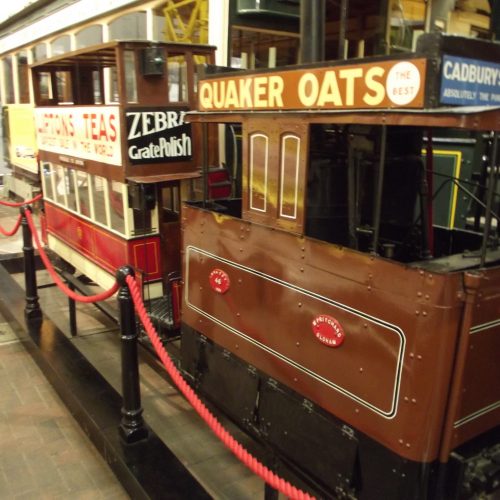
Explore the Tramway Museum and Relive Luxembourg’s Transport Heritage
The Tramsmusée, located near the bustling headquarters of the City of Luxembourg‘s Service Autobus (Bus Department), offers tourists a thrilling ride through the rich tapestry of Luxembourg’s public transportation history. Explore the perfectly restored trams and buses, as well as 1:8-scale models and a spacious display space.
A Journey Through Time: A Look at the Past
In the early 1960s, an important turning point occurred when plans to phase out the tram system in favor of buses became a reality. The confluence of the City of Luxembourg’s millennium celebration in 1963 and the final electric tram trip in 1964 prompted the Service Autobus workshops to produce astonishingly accurate 1:8-scale tram models. This was the beginning of an ongoing collection that included not just model trams and buses but also a variety of artifacts such as controller uniforms, tickets, punchers, maps, and blueprints.
Complex Models: Observing Evolution
Observing these detailed models, visitors obtain a comprehensive understanding of the evolution of these vehicles across time.
The purchase of thousands of papers, which offer a thorough historical tour, demonstrates the museum’s commitment to preserving the story of mobility in Luxembourg City.
A Technological Showcase in the Living Exhibit
The Tramsmusée now houses two operating electric trams, two tram engines, a life-size model of a horse-drawn tram, two buses, and an eye-catching Ford truck used for catenary maintenance. Expertly guided tours and full explanatory plans bring mechanics aficionados up close and personal with the dynamic engine and gear systems, uncovering the technological complexities. Whether you’re looking for cutting-edge technical discoveries or nostalgic melancholy, this museum has something for everyone.
Investigating technological wonders
Investigate the operating subtleties of electric trams, listen to the heartbeat of tram engines, and marvel at the Ford wagon’s fastidious maintenance techniques. The Tramsmusée provides an immersive experience that bridges the gap between historical relevance and modern engineering.
Historical Milestones on the Trail
The museum digs at major stages in Luxembourg’s transport evolution:
- Horse-Drawn Trams, 1875–1908
- A three-kilometer-long network that marks the city’s first foray into public transportation.
Inauguration of the Electric Tramway in August 1908. - The formal unveiling marked the end of horse-drawn trams and the beginning of a new era with an electrified network.
The transition to buses began on September 5, 1964.
Opening Hours and Admission Fee
- Thursday:13:30-17:30
- Saturdays, Sundays, and legal holidays: 10:00AM–6:00PM
- (Closed on November 1st, All Saints’ Day)
Appointments are required for guided tours.
Admission is free of charge.
At the Tramsmusée, take a trip through Luxembourg’s transport history, where each exhibit offers a story of invention, development, and the lasting spirit of mobility.
Explore the Musée Dräi Eechelen and Uncover Luxembourg’s Industrial Heritage
The Musée Dräi Eechelen, or Three Acorns Museum, is located in the Kirchberg neighborhood of Luxembourg City, within the Grand Duchy of Luxembourg. It is a tribute to the rich history of this attractive location. Let us explore the historical tapestry that has been weaved inside the walls of the fully restored 18th-century Fort Thüngen.
Fort Thüngen: A Time Fortress
Our adventure begins with the construction of Fort Thüngen in 1732 by the Austrians to strengthen the Fortress of Luxembourg. This fortress was expanded throughout time, most notably by the Prussians in 1836 and 1859–60, contributing to the Grünewald Front—the outer fortifications. Following the Treaty of London in 1867, a large section of the fort was demolished, leaving behind its unique three-rounded turrets, lovingly known as Dräi Eechelen in Luxembourgish or Les Trois Glands in French, translating to “The Three Acorns.”
The Musée de la Forteresse: From Idea to Reality
Authorities in Luxembourg approved the conversion of Fort Thüngen into the Musée de la Forteresse in 1996 with the intention of clearly illustrating Luxembourg’s fortress history, city development, territorial growth, and national cultural identity.
Highlights from the Permanent Exhibition The Chronicles Unfold
1443-1643 Casemates Chronicles
Step into the enthralling casemates, underground galleries that exhibit about 600 items chronicling Luxembourg’s tale, from the Burgundian invasion in 1443 until the completion of the Adolphe Bridge in 1903. The first six casemates depict historical shifts throughout the medieval fortification era (1443–1643).
Peak Development Period: 1883–1903
Explore the following series of casemates, which highlight the city’s development from 1883 to 1903. Artifacts come to life here, bringing to life the dramatic years that created Luxembourg’s environment.
Immersive Spaces: A Multimedia Room with Snapshots from the Nineteenth Century
Two more casemates house an immersive multimedia space and an intriguing collection of nineteenth-century photos. These places offer a dynamic perspective on Luxembourg’s growth throughout this important period.
The Structure as a Time Capsule
Aside from the items, the construction of the Musée Dräi Eechelen forms an important part of the show. The structure, meticulously restored to reflect its 1837 extension, provides a physical link to the past.
At Musée Dräi Eechelen, echoes of Luxembourg’s past reverberate through objects and architecture, offering an immersive experience for history buffs and curious minds alike.
The artifacts collected by Villa Vauban are drawn from three unique collections donated to the city.
Opening Hours
Monday is a holiday.
The Musée Dräi Eechelen is closed on Mondays. Visit on any other day to really immerse yourself in the historical trip that this museum provides.
Tuesday, 10:00 a.m. to 6:00 p.m.
Every Tuesday from 10:00 a.m. to 6:00 p.m., start your workday journey by visiting the museum. During these hours, you are free to explore the exhibits and artifacts at your leisure.
Wednesday, 10:00 a.m. to 8:00 p.m.
Extend your cultural experience over the week! On Wednesdays, the Musée Dräi Eechelen stays open until 8:00 PM, giving you plenty of opportunity to dig into Luxembourg’s interesting past.
Thursday, 10:00 a.m. to 6:00 p.m.
Continue your historical journey on Thursdays, when the museum is open from 10:00 a.m. until 6:00 p.m. Use the immersive exhibitions and intriguing displays to your advantage.
Friday, 10:00 a.m. to 6:00 p.m.
Begin the weekend by visiting Musée Dräi Eechelen on Fridays, when the museum is open from 10:00 a.m. until 6:00 p.m.
Saturday, 10:00 a.m. to 6:00 p.m.
Saturdays are another great day to explore the museum’s treasures. To make the most of your weekend cultural adventure, visit between 10:00 AM and 6:00 PM.
Sunday, 10:00 a.m. to 6:00 p.m.
Finish your week with a visit to Musée Dräi Eechelen, which is open from 10:00 a.m. to 6:00 p.m. on Sundays. Explore the exhibitions and immerse yourself in Luxembourg’s rich history.
Before arranging your visit, please check for any updates or changes to the operation hours. The Musée Dräi Eechelen invites you to take a trip through time within its walls.
Pricing
€5 for adults
The entry fee for adult visitors eager to learn about the museum’s rich history is €5. Explore the fascinating exhibits and artifacts that trace Luxembourg’s history, from the Burgundian invasion to the construction of the Adolphe Bridge.
€5 reduced entrance fee
Benefit from a €5 admission price that is affordable without sacrificing the entire experience. This discounted charge applies to specified categories, ensuring that a wide range of visitors can enjoy the cultural treasures held at Musée Dräi Eechelen.
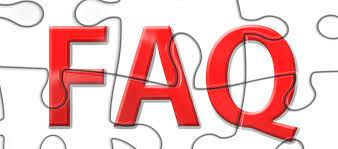
FAQ
1. What are the best museums in Luxembourg to visit?
If you’re planning a trip to Luxembourg, you’ll definitely want to make time to explore the best museums in the grand duchy. Some of the must-visit museums include the national museum, Mudam, and the Luxembourg City Museum.
2. What are the top 10 museums in Luxembourg City?
Luxembourg City is a treasure trove of cultural and historical attractions, and its top 10 museums include the Casino Luxembourg, Mudam, and the Luxembourg City History Museum.
3. What is the most popular museum in Luxembourg?
One of the most popular museums in Luxembourg is the Musée d’Art Moderne Grand-Duc Jean, commonly known as Mudam. It’s a prominent venue for contemporary art and design.
4. Are there any free entry museums in Luxembourg?
Yes, there are quite a few museums in Luxembourg that offer free entry. Some of them include the Museum of Natural History
5. Which museums in Luxembourg focus on modern art?
If you’re a fan of modern art, you should definitely check out the Musee Grand Duc Jean and the Casino Luxembourg. These museums showcase some incredible contemporary artwork.
6. What can I expect at the National Museum of History and Art?
The Museum of History and Art in Luxembourg offers a fascinating glimpse into the rich history of Luxembourg. You’ll find remarkable exhibits that highlight the cultural and historical heritage of the country.
7. Where can I find museums with temporary exhibitions in Luxembourg?
If you’re interested in exploring temporary exhibitions, be sure to visit the Luxembourg City Museum.
Conclusion
As you begin your cultural journey through Luxembourg’s museums, keep in mind that these institutions are more than just repositories of relics and displays; they are also active hubs of creativity, innovation, and learning. They act as links between the past, the present, and the future, safeguarding the legacy of Luxembourg’s rich heritage while nurturing a vibrant cultural environment.
From the cutting-edge art of Mudam Luxembourg to the enthralling medieval fortifications of the Villa Vauban, Luxembourg’s museums provide a rich tapestry of experiences that will deepen your knowledge of the city’s distinct character and continuing cultural spirit. So, go beyond the conventional sights and sounds of tourist sites and explore Luxembourg’s museums. You will not be let down.

